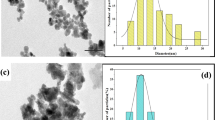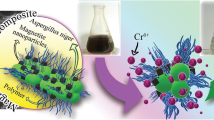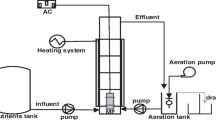Abstract
This study investigated the deep removal of complex nickel from simulated wastewater using magnetic separation and magnetic seed recycling. Nano-magnetite (Fe3O4) was used as the magnetic seed. The flocculant applied was N,N-bis-(dithiocarboxy) ethanediamine (EDTC), a highly efficient heavy metal chelating agent included in dithiocarbamate (DTC). Important investigated parameters included hydraulic retention time, magnetic seed dosage, and magnetic field strength. The study also explored the magnetic flocculation mechanism involved in the reaction. The result indicated that the residual Ni concentration was reduced to less than 0.1 mg/L from the initial concentration of 50 mg/L under optimal conditions. Magnetic seed recovery reached 76.42% after a 3-h stirring period; recycled magnetic seeds were analyzed using scanning electron microscope (SEM) and X-ray diffraction (XRD). The zeta potential results illustrated that magnetic seeds firmly combined with flocs when the pH ranged from 6.5 to 7.5 due to the electrostatic attraction. When the pH was less than 7, magnetic seeds and EDTC were also combined due to electrostatic attraction. Particle size did affect microfloc size; it decreased microfloc size and increased floc volume through magnetic seed loading. The effective binding sites between flocs and magnetic seeds increased when adding the magnetic seeds. This led the majority of magnetic flocs to be integrated with the magnetic seeds, which served as a nucleus to enhance the flocculation property and ultimately improve the nickel complex removal rate.













Similar content being viewed by others
References
Chang JX, Wang SF, Chen X (2011) Research on the treatment of Ni2+-containing wastewater by ferrite co-precipitation process. Industrial Water Treatment 31(3):46–47 (in Chinese)
Chen JY, Hao YM, Chen M (2013) Rapid and efficient removal of Ni2+ from aqueous solution by the one-pot synthesized EDTA-modified magnetic nanoparticles. ENVIRON SCI POLLUT R 21:1671–1679
Eom TH, Lee CH, Kim JH, Lee CH (2005) Development of an ion exchange system for plating wastewater treatment. Desalination 180(1):163–172
Guan DX, Yuan LM, Jin XY, He D (2014) Treatment of coal-to-oil production wastewater enhanced by magnetic flocculation technology. ENVIRON SCI TECHNOL 37(9):141–144 (in Chinese)
He XW, Hu JL, Li JW, Zhang JJ, Wang JB, Ge P (2013) Treatment of wastewater containing lead by sodium sulfide precipitation. Chinese Journal of Environmental Engineering 7(4):1394–1398 (in Chinese)
Kabdasli I, Arslan T, Hancıa TÖ, Alatona IA, Tünay O (2009) Complexing agent and heavy metal removals from metal plating effluent by electrocoagulation with stainless steel electrodes. J Hazard Mater 165(1–3):838–845
Kang XH, Yang YL (2011) An experimental study on removal of copper ions from industrial wastewater by magnetic flocculation. Industrial Water and Wastewater 42(3):24–27 (in Chinese)
Kapoor A, Viraraghavan T, Cullimore DR (1999) Removal of heavy metals using the fungus Aspergillus niger. BIORESOURCE TECHNOL 70:95–104
Kozlowski CA, Walkowiak W (2002) Removal of chromium (VI) from aqueous solutions by polymer inclusion membranes. Water Res 36(19):4870–4876
Li JX (2014) Application of magnetic coagulation process for slightly polluted river water treatment. Chinese Journal of Environmental Engineering 8(7):2901–2905 (in Chinese)
Li SQ, Wang MF, Zhu ZA, Wang Q, Zhang X, Song HQ, Cang DQ (2010a) Application of superconducting HGMS technology on turbid wastewater treatment from converter. Sep Purif Technol 84:56–62
Li YR, Wang J, Zhao Y, Luan ZK (2010b) Research on magnetic seeding flocculation for arsenic removal by superconducting magnetic separation. Sep Purif Technol 73:264–270
Liu D, Wang P, Wei GR, Dong WB, Hui F (2012) Removal of algal blooms from freshwater by the coagulation-magnetic separation methond. ENVIRON SCI POLLUT R 20:60–65
Fang M, Mishima F, Akiyama Y, Nishijima S (2010) Fundamental study on magnetic separation of organic dyes in wastewater. Physica C 470:1827–1830
Nuray K (2003) Magnetic separation of ferrihydrite from wastewater by magnetic seeding and high-gradient magnetic separation. Miner Process 71:45–54
Prochazkova G, Podolova N, Safarik L et al (2013) Physicoshemical approach to freshwater microalgae harvesting with magnetic particles. COLLOID SURFACE B 112:213–218
Qi YS (2011) The treatment of electroplating effluent with low content of complex copper and complex nickel. Shandong University (in Chinese)
Ritu DA, Mika S (2010) Water purification using magnetic assistance: a review. J Hazard Mater 180:38–49
Shen YL (2005) The study of treating wastewater containing heavy metal ions by the DDTC and composite flocculants. Xichang University (in Chinese)
Shen ZP, Mei RW, Wei YF (2014) Pilot research on treating wastewater by magnetic flocculation. Environ Eng 32:367–368 (in Chinese)
Timothy PC, Dorothy ML, Elizabeth TS (1989) Toxicity and careinogenieity of nickel compounds. Critieal Reviewsin Toxieology 19:341–384
Wang HK (2013) Treatment of electroplating wastewater containing heavy metal. Plating and Finishing 35(3):75–78 (in Chinese)
Wang J, Yang SS, Jia H, Liu LL, Wen ZW, Yang G, Guo SN, Bai JD (2015) Magnetic flocculation technology in turbidity removal of high turbidity seawater for desalination pretreatment. Journal of Tianjin Polytechnic University 34(4):18–21 (in Chinese)
Xiao X, Sun SY, Yan PF, Qiu YQ, Ye MY (2015) The structure characterization of highly-efficient heavy metal chelating agent EDTC and its characteristics of acid complex copper removal. Acta Sci Circum Stantiae 36(2):537–543 (in Chinese)
Xiao X, Qiu YQ, Sun SY, Ye MY, Yan PF, Ye ZW (2016a) Research on the characteristics of tracecomplex nickel ions deep removal by N, N′-bis-(dithiocarboxy) ethylenediamine. Acta Sci Circum Stantiae 36(9):3251–3257 (in Chinese)
Xiao X, Ye MY, Yan PF, Qiu YQ, Sun SY, Ren J, Dai YK, Han DJ (2016b) Disodium N,N-bis-(dithiocarboxy)ethanediamine: synthesis, performance, and mechanism of action toward trace ethylenediaminetetraacetic acid copper (II). Environ Sci Pollut Res 23:19696–19706
Xu L, Guo C, Wang F, Zheng S, Liu CZ (2011) A simple and rapid harvesting method for microalgae by in situ magnetic separation. BIORESOURCE TECHNOL 102:10047–10051
Yan L, Yu XJ, Li SQ (2009) Treatment of spent electroplating nickel bath by electrolytic method. Journal of Shenyang Jianzhu University (Natural Science) 25(4):762–766 (in Chinese)
Yan PF, Sun SY, Ye MY, Xiao X, Liu JY (2015) Research on the efficiency and mechanism of low-concentration Ni removal from electroplating wastewater by the heavy metal capturing agent with thiol. Acta Sci Circum Stantiae 35(9):2833–2839 (in Chinese)
Zhang SF, Hu XE (2011) Application of pulse electrodeposition to nickel wastewater treatment. Environmental Science and Management 36(11):91–94
Zhang Z, Yang YL (2012) Experimental study on advanced treatment of coking wastewater by magnetic flocculation technology. Industrial water and wastewater 43(2):25–29 (in Chinese)
Zhao Y, Xi BD, Li YR, Wang MF, Zhu Z, Xia XF, Zhang LY (2012) Removal of phosphate from wastewater by using open gradient superconducting magnetic separation as pretreatment for high gradient superconducting magnetic separation. Sep Purif Technol 86:255–261
Zhen HB, Xu Q, Hu YY, Cheng JH (2012) Characteristics of heavy metals capturing agent dithiocarbamate (DTC) for treatment of ethylene diamine tetraacetic acid-Cu (EDTA-Cu) contaminated wastewater. J CHEM ENG 209:547–557
Zhou XL, Lu JT (2009) Characterization and properties of modified coal fly ash adsorbent for removal of nickel (II) ions from solution. Clean Coal Technology 16(2):97–100
Zuo M, Wang XJ (2011) Treatment of wastewater containing nickel, chromium, zinc and copper by ferrite process. Electroplating and Finishing 30(7):48–50 (in Chinese)
Acknowledgements
This research was supported by the National Natural Science Foundation of Guangdong Province (No. 2015A030308008), Science and Technology Planning Project of Guangdong Province (No. 2016A040403068), and Special Fund of Department of Environmental Protection of Guangdong Province (2016).
Author information
Authors and Affiliations
Corresponding author
Additional information
Responsible editor: Angeles Blanco
Electronic supplementary material
ESM 1
(DOCX 844 kb)
Rights and permissions
About this article
Cite this article
Qiu, Y., Xiao, X., Ye, Z. et al. Research on magnetic separation for complex nickel deep removal and magnetic seed recycling. Environ Sci Pollut Res 24, 9294–9304 (2017). https://doi.org/10.1007/s11356-017-8563-y
Received:
Accepted:
Published:
Issue Date:
DOI: https://doi.org/10.1007/s11356-017-8563-y




